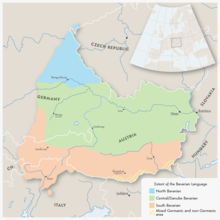
Back Beiers Afrikaans Bairisch ALS Idioma bavaro AN البافارية Arabic Idioma austrobávaru AST Bavariya dili Azerbaijani Boarisch BAR Баварскі дыялект Byelorussian Баварскі дыялект BE-X-OLD Австро-баварски диалекти Bulgarian
| Austro-Bavarian | |
|---|---|
| Bairisch | |
| Pronunciation | German [baɪʁɪʃ] |
| Region | Austria, Bavaria, and South Tyrol |
| Ethnicity | Austrians Bavarians South Tyroleans |
Native speakers | 14,000,000 (2016)[1] |
| Language codes | |
| ISO 639-3 | bar |
| Glottolog | baye1239 Bairischbava1246 Bavarian |
 Extent of the Austro-Bavarian language | |
Bavarian (also known as Austro-Bavarian; German: Bairisch [ˈbaɪ̯ʁɪʃ] (![]() listen)) is a major group of Upper German varieties. They are called "upper" because they are spoken in Switzerland, Austria and southern Germany, which are mountainous. Like standard German, Austro-Bavarian is a High German language, but they are not the same language. However, Austro-Bavarian and Standard German have influenced each other and the vast majority of Austro-Bavarian speakers speak Standard German as well. There are more variants of Bavarian. The variants are Central Bavarian, Southern Bavarian, and Northern Bavarian.
listen)) is a major group of Upper German varieties. They are called "upper" because they are spoken in Switzerland, Austria and southern Germany, which are mountainous. Like standard German, Austro-Bavarian is a High German language, but they are not the same language. However, Austro-Bavarian and Standard German have influenced each other and the vast majority of Austro-Bavarian speakers speak Standard German as well. There are more variants of Bavarian. The variants are Central Bavarian, Southern Bavarian, and Northern Bavarian.
Austro-Bavarian is also used to refer to the dialect group which includes the Austro-Bavarian dialect discussed here, as well as the Cimbrian, Hutterite German, and Mócheno dialects of Germany.
- ↑ Austro-Bavarian at Ethnologue (18th ed., 2015)